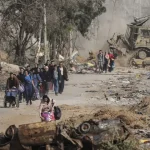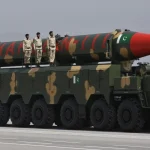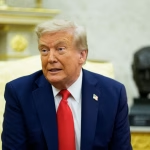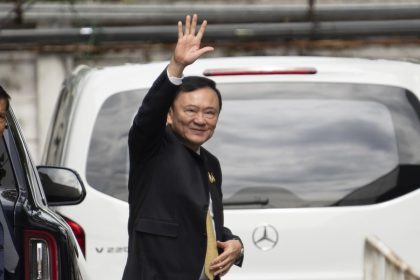In a world already reeling from trade disputes, geopolitical rivalries, and fragile supply chains, a fresh spark has ignited tensions. Beijing has strongly condemned Washington after the United States imposed 50% tariffs on Indian exports, calling the move a display of “bully tactics.” China, while not directly affected by this particular tariff hike, has positioned itself as a vocal critic of U.S. trade policies, framing the action as part of a larger pattern of economic coercion.
The development has sent ripples across Asia and beyond. Analysts suggest this escalation could reshape not only U.S.-India relations but also the broader global trade landscape. At a time when nations are trying to stabilize their economies after the pandemic and ongoing conflicts, such aggressive tariffs risk deepening divisions and accelerating the fragmentation of global trade.
This article takes a deep dive into the incident, its historical context, the reactions from Beijing and New Delhi, the economic consequences, and the larger implications for international trade.
The Trigger: U.S. Tariffs on India
The United States recently announced a 50% tariff on a wide range of Indian goods, citing concerns about “unfair trade practices” and “imbalances” in market access. The move primarily targets sectors such as textiles, pharmaceuticals, and agricultural products—industries in which India has gained competitive ground in the global market.
For Washington, the justification rests on protecting American industries from cheaper imports and pushing India to open its markets further. However, critics argue that the scale of the tariff is unprecedented and punitive, designed less to protect U.S. businesses and more to assert dominance in the shifting global economic order.
According to trade data, India exports over $80 billion worth of goods annually to the U.S., making America one of its largest markets. A 50% tariff threatens not only Indian exporters but also American consumers, who will likely face higher prices for goods ranging from cotton garments to generic medicines.
Beijing’s Reaction: Condemning U.S. “Bully Tactics”
China was quick to respond, even though it was not directly targeted. The Chinese Foreign Ministry issued a statement labeling Washington’s move as “bully tactics” and warning that such unilateralism undermines the rules-based global trading system.
“By imposing such excessive tariffs on India, the United States is once again weaponizing trade to pursue political ends,” said a Chinese government spokesperson. “This is not about fair trade, but about coercion and control.”
Beijing’s strong words are not surprising. Over the past decade, China itself has been at the receiving end of U.S. tariffs, particularly under former President Donald Trump’s trade war. By siding with India—at least rhetorically—China is attempting to frame Washington as an aggressor and position itself as a defender of global economic fairness.
India’s Dilemma: Between Washington and Beijing
For India, the situation is delicate. On one hand, the U.S. remains a vital strategic partner in defense and technology, especially as both nations attempt to counter China’s influence in Asia. On the other hand, such steep tariffs threaten India’s export-driven industries and could stall economic growth.
New Delhi’s official reaction has been restrained but firm. Indian trade officials have called the tariffs “disproportionate and damaging” and hinted at possible retaliatory measures, including raising tariffs on U.S. agricultural imports.
However, India faces a tough balancing act. If it retaliates too strongly, it risks escalating a trade war with one of its largest markets. If it concedes, it could be perceived as weak domestically.
Historical Context: U.S. Trade Wars and Global Fallout
This is not the first time Washington has used tariffs as a weapon in trade disputes. In 2018, the Trump administration imposed heavy tariffs on Chinese goods, sparking a tit-for-tat trade war that disrupted global markets. Similar tensions emerged with the European Union, Canada, and Mexico.
Those disputes cost global businesses billions and contributed to supply chain bottlenecks. According to the Peterson Institute for International Economics, the U.S.-China trade war alone reduced U.S. GDP by nearly 0.3% annually and raised costs for consumers.
By imposing massive tariffs on India, Washington appears to be following the same playbook. But unlike previous disputes, this move could have wider geopolitical implications. India is not just an economic rival but also a key U.S. ally in the Indo-Pacific strategy.
Economic Impact on India
The 50% tariff will hit Indian exporters hard. Textile manufacturers, who supply everything from cotton shirts to home furnishings to the U.S., will face an uphill battle competing with higher costs. Pharmaceuticals—especially generic medicines, which India exports in large volumes to the U.S.—may see declining demand as prices rise.
Economists warn that the tariffs could shave off 0.5% to 1% of India’s GDP growth if sustained over the next year. This comes at a time when India is trying to position itself as the world’s next manufacturing hub, offering an alternative to China.
The timing could not be worse. Inflation in India remains stubbornly high, unemployment is a persistent challenge, and now a major export sector is under threat.
Impact on U.S. Consumers and Businesses
While Washington frames tariffs as a way to protect American workers, the reality is more complex. Higher tariffs often translate into higher consumer prices. U.S. importers will either absorb the cost or pass it on to buyers.
Generic medicines from India, which account for nearly 40% of U.S. prescriptions, may become significantly more expensive. Clothing and household items, too, could see price hikes.
American businesses that rely on Indian suppliers, particularly in pharmaceuticals and IT services, may also struggle with higher operating costs. In effect, U.S. consumers and companies will share the burden of Washington’s aggressive trade stance.
Beijing’s Strategic Play
Beijing’s condemnation of the U.S. is not merely about principles—it is a calculated move. By defending India against U.S. tariffs, China is attempting to drive a wedge between Washington and New Delhi.
While India and China have had tense relations, particularly after the 2020 border clashes, Beijing sees an opportunity to exploit India’s frustration with Washington. By painting itself as a fellow victim of U.S. trade aggression, China hopes to weaken the U.S.-India strategic partnership.
“China is playing the long game here,” noted Dr. Li Ming, a Beijing-based trade analyst. “By standing with India, even rhetorically, Beijing is sending a signal that the U.S. is the real destabilizing force in Asia.”
Global Repercussions
The U.S. tariffs on India could set off a chain reaction. Other countries may begin reassessing their trade relations with Washington, fearing they could be the next target.
The World Trade Organization (WTO) is also under pressure. India is expected to file a formal complaint, but with the WTO’s dispute resolution system weakened in recent years, enforcement remains uncertain.
Global investors are watching closely. Trade disputes increase uncertainty, which often leads to volatility in financial markets. Already, stock markets in Asia have shown signs of nervousness, with declines in India’s textile and pharma sectors.
Expert Opinions
Dr. Arvind Subramanian, former Chief Economic Advisor to India: “This is a wake-up call for India to diversify its export markets. Over-reliance on the U.S. has made us vulnerable to political shifts.”
Michael Kugelman, South Asia expert: “The tariffs complicate U.S.-India relations at a time when Washington needs New Delhi as a counterweight to China.”
WTO trade official (anonymous): “Such unilateral actions erode confidence in the multilateral trading system. If big economies continue to bypass the rules, global trade will suffer.”
Possible Scenarios Ahead
Negotiated Settlement: India and the U.S. may enter talks to reduce tariffs in exchange for concessions on market access.
Retaliation by India: New Delhi may impose tariffs on U.S. agricultural products or energy imports.
Trade War Escalation: Both sides raise tariffs further, damaging industries and raising consumer prices.
Geopolitical Realignment: India may edge closer to China or other trade partners as a counterbalance to U.S. pressure.
FAQs
Why did the U.S. impose a 50% tariff on Indian goods?
The U.S. cited unfair trade practices and market imbalances, but analysts suggest it is also a strategic move to assert dominance in global trade.
How has China reacted to the tariffs?
Beijing condemned the move as “bully tactics” and accused Washington of undermining the global trading system.
What sectors in India will be most affected?
Textiles, pharmaceuticals, and agricultural exports are expected to be hardest hit.
Will U.S. consumers face higher prices?
Yes. The tariffs will likely raise costs of Indian imports, including clothing and generic medicines, in the U.S. market.
Could this lead to a U.S.-India trade war?
It is possible if India retaliates with tariffs of its own. The situation will depend on how negotiations unfold.
What role is China playing in this dispute?
China is using the opportunity to criticize Washington and portray itself as a defender of fair trade, hoping to weaken U.S.-India relations.
What does this mean for global trade?
The move adds to growing concerns about protectionism and could further erode confidence in the multilateral trading system.
Conclusion
The imposition of 50% U.S. tariffs on Indian goods is more than a trade dispute—it is a geopolitical flashpoint. Beijing’s condemnation and framing of the move as “bully tactics” underscores the growing rivalry between Washington and China, while also complicating U.S.-India ties.
India now faces tough choices. Retaliate and risk a trade war, or concede and weaken its bargaining power. Meanwhile, China will continue to exploit the moment, casting itself as a defender of fair trade.
What is clear is that the global trading system is under strain. Unilateral tariffs, rising protectionism, and geopolitical rivalries are reshaping how nations do business. The world’s economies, already fragile, can ill afford another prolonged trade war.













